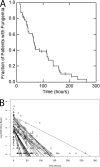Population Pharmacodynamics of Amphotericin B Deoxycholate for Disseminated Infection Caused by Talaromyces marneffei
- PMID: 30420478
- PMCID: PMC6355582
- DOI: 10.1128/AAC.01739-18
Population Pharmacodynamics of Amphotericin B Deoxycholate for Disseminated Infection Caused by Talaromyces marneffei
Abstract
Amphotericin B deoxycholate (DAmB) is a first-line agent for the initial treatment of talaromycosis. However, little is known about the population pharmacokinetics and pharmacodynamics of DAmB for talaromycosis. Pharmacokinetic data were obtained from 78 patients; among them, 55 patients had serial fungal CFU counts in blood also available for analysis. A population pharmacokinetic-pharmacodynamic model was fitted to the data. The relationships between the area under the concentration-time curve (AUC)/MIC and the time to blood culture sterilization and the time to death were investigated. There was only modest pharmacokinetic variability in the average AUC, with a mean ± standard deviation of 11.51 ± 3.39 mg·h/liter. The maximal rate of drug-induced kill was 0.133 log10 CFU/ml/h, and the plasma concentration of the DAmB that induced the half-maximal rate of kill was 0.02 mg/liter. Fifty percent of patients sterilized their bloodstreams by 83.16 h (range, 13 to 264 h). A higher initial fungal burden was associated with a longer time to sterilization (hazard ratio [HR], 0.51; 95% confidence interval [CI], 0.36 to 0.70; P < 0.001). There was a weak relationship between AUC/MIC and the time to sterilization, although this did not reach statistical significance (HR, 1.03; 95% CI, 1.00 to 1.06, P = 0.091). Furthermore, there was no relationship between the AUC/MIC and time to death (HR, 0.97; 95% CI, 0.88 to 1.08; P = 0.607) or early fungicidal activity {slope = log[(0.500 - 0.003·(AUC/MIC)]; P = 0.319} adjusted for the initial fungal burden. The population pharmacokinetics of DAmB are surprisingly consistent. The time to sterilization of the bloodstream may be a useful pharmacodynamic endpoint for future studies. (This study has been registered at the ISRCTN registry under no. ISRCTN59144167.).
Keywords: PK-PD; Penicillium; Talaromyces; amphotericin; antifungal; pharmacodynamics; population pharmacokinetics; talaromycosis.
Copyright © 2019 Le et al.
Figures




References
-
- Le T, Wolbers M, Chi NH, Quang VM, Chinh NT, Lan NPH, Lam PS, Kozal MJ, Shikuma CM, Day JN, Farrar J. 2011. Epidemiology, seasonality, and predictors of outcome of AIDS-associated Penicillium marneffei infection in Ho Chi Minh City, Viet Nam. Clin Infect Dis 52:945–952. doi:10.1093/cid/cir028. - DOI - PMC - PubMed
-
- Le T, Kinh NV, Cuc NTK, Tung NLN, Lam NT, Thuy PTT, Cuong DD, Phuc PTH, Vinh VH, Hanh DTH, Tam VV, Thanh NT, Thuy TP, Hang NT, Long HB, Nhan HT, Wertheim HFL, Merson L, Shikuma C, Day JN, Chau NVV, Farrar J, Thwaites G, Wolbers M. 2017. A trial of itraconazole or amphotericin B for HIV-associated talaromycosis. N Engl J Med 376:2329–2340. doi:10.1056/NEJMoa1613306. - DOI - PubMed
Publication types
MeSH terms
Substances
Associated data
Grants and funding
LinkOut - more resources
Full Text Sources

